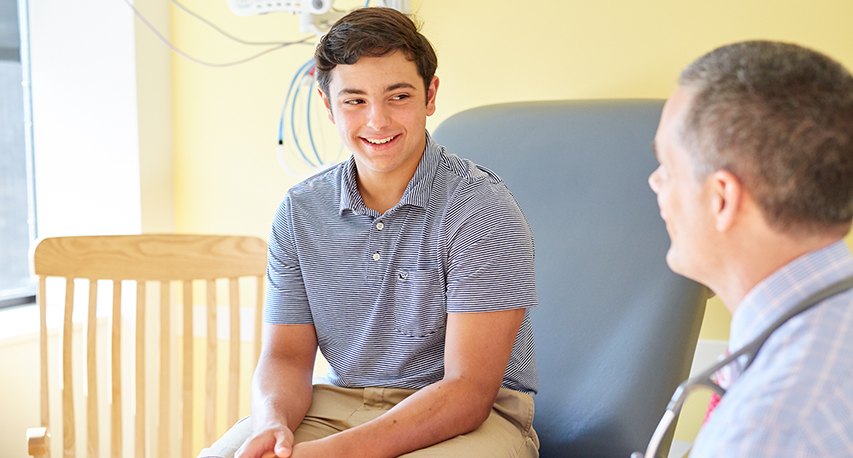
Advances in Pulmonary Hypertension: Q&A with Russel Hirsch, MD
 In March, Cincinnati Children’s became the first pediatric institution worldwide to receive regulatory approval to enroll patients in a new drug trial for treating pulmonary hypertension. The drug has generated encouraging results.
In March, Cincinnati Children’s became the first pediatric institution worldwide to receive regulatory approval to enroll patients in a new drug trial for treating pulmonary hypertension. The drug has generated encouraging results.
We checked in with Russel Hirsch, MD, director of the Cincinnati Children’s Pulmonary Hypertension Program, about how the trial is going and his team’s treatment approach for patients who have this progressive, life-threatening disease. Here’s what he had to say.
Q: What is the new drug being studied for pulmonary hypertension treatment?
A: The new drug is sotatercept (WINREVAIRTM). It is likely the most transformative change in pulmonary hypertension care in recent years. Compared with other available drugs, it impacts the abnormal primary signaling that results in the blood vessels in the lung becoming abnormal. It in effect rebalances the signals and attempts to recreate a normal physiologic balance. The results from the adult studies were very promising, and the drug was approved for use in adults in March of this year. We are now moving to advance the use of it in pediatrics.
Fortunately, we were the first institution in the world to receive regulatory approval to run the trial in pediatrics and enroll patients in the first phase, which was for ages 12 to 18. Very soon, we hope to advance the trial into the younger age groups as well.
Q: How does the drug work?
A: Sotatercept is a class of drug called ligand binders. It neutralizes circulating factors that result in the changes that cause the vessels to become abnormal in pulmonary vascular occlusive disease. Other drugs serve as pulmonary blood vessel dilators, although at times, the disease may be so far advanced that the vessels are unable to dilate. Fortunately, sotatercept can be used as an add-on drug, and generally seems to be well tolerated.
Patients who have taken sotatercept have had positive outcomes such as being able to come off of oxygen and walk substantially longer distances. That’s very exciting in a disease that has a significant impact on quality of life and carries a high rate of both morbidity and mortality.
Q: What else is your team doing to advance care for patients with pulmonary hypertension?
A: Our team prides itself on focusing on the whole patient, not just their pulmonary hypertension. With about 500-1,000 people diagnosed with new cases of pulmonary hypertension each year, we have come to understand that the risk for these patients is diminished with a care approach that involves a cohesive team with a broad range of experiences.
Collaboration is a critical component of our team and allows us to be very detailed and customized in the care we provide. Children with pulmonary hypertension have a lot of needs, so having a consistent clinical team reduces anxiety. It also allows us to discuss all treatment options in an open and transparent manner.
Our team also partners with other disciplines when needed, including working with some incredibly experienced pulmonary and cardiothoracic surgeons. That means our patients have access to all potential forms of treatment—from the initial clinic evaluations, the latest medications including triple therapy, and the surgical options of reverse Potts shunts and lung transplantation—all under the same roof.
Q: What are some of the outcomes your team has achieved?
A: Our team has treated several young patients with pulmonary hypertension who have now transitioned over to the adult side and live productive lives, in part because of the advanced care they received here. We attract patients from a wide geographic area, and we believe this has further positively impacted outcomes when patients do not have immediate access to large medical centers.
In addition, as an adjunct to our pulmonary hypertension program, we also have an aggressive pulmonary vein stenosis program which is incorporated within the structure of our Pulmonary Hypertension Program. Further, we work closely with the Pediatric Lung Transplant Program and End-stage Lung Failure Program. This high level of integrated care results in better outcomes and quality of life for our patients.
Q: What is your vision for pulmonary hypertension care moving forward?
A: Simply put, we hope for a cure. As we better understand the underlying genetic and molecular mechanisms that drive the disease, our advances in therapies will target each specific cause, then arrest and then reverse the disease. That would be a huge step forward, and we are going to continue working toward that.
Dr. Hirsch is a pediatric cardiologist who has been the director of the Pulmonary Hypertension Program at Cincinnati Children’s since 2005. He and his team provide comprehensive diagnostic and long-term treatment and follow-up for patients with pulmonary hypertension. They can be contacted at 513-636-4432.

